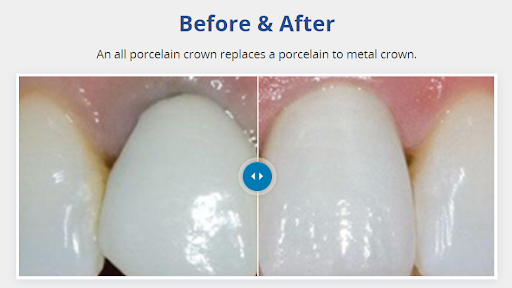What are Dental Crowns and Bridges?
Many of us have needed some form of dental work done. A dental crown and dental bridge make up a huge part of the dental field in terms of treatment options. These restorations are used to help restore smiles and improve overall well-being.

A dental crown can help save a tooth from having to be extracted, while a dental bridge can help fill the gap where a tooth was lost. This article will give complete information about Dental Crown and Dental Bridge.
- The North American Dental Crown and Bridges Market, most recently noted to be worth 1.09 billion US dollars in 2022, is expected to reach 1.55 billion US dollars by 2027.
What are Dental Crown and Dental Bridges?
Dental crown and bridge can increase the longevity of your smile. In this section, we will discuss these common restorative dentistry options that help replace or support missing or damaged teeth.
Dental Crown
What is a dental crown? Here’s a breakdown of this dental restoration.
Dental crowns are sometimes referred to as tooth caps. These restorations cover a damaged or misshaped tooth for functional and aesthetic purposes. They can be made of a variety of materials, including porcelain, zirconium, gold, or other metal alloys.
Dental Bridge
What’s a dental bridge? Read more below to learn more about this common dental treatment.
Dental bridges are a great option for individuals looking to replace one or more teeth in a row. A bridge is made up of a natural-looking artificial tooth held together by dental crowns on either side of the gap. Similar to dental crowns, bridges can be made from a variety of materials, such as porcelain, zirconium, gold, or other metal alloys.
How Do Crowns and Bridges Actually Work?
The process of crowns and bridges is simple. In the section below, you can learn all about how crowns and bridges actually work.
How Does Dental Crown Work?
First, we will discuss how a dental crown works. A dental crown works by adding total coverage over your natural tooth. They are cemented onto teeth, making it a permanent restoration. This provides extra protection and a stronger chewing surface. The dental crown will function just like the rest of your natural teeth.
How Do Dental Bridges Work?
Here we discuss how dental bridges work. A dental bridge works by replacing one or more missing teeth with an artificial pontic tooth. The pontic is held in place by two neighboring teeth that are covered by dental crowns, creating one connected unit of teeth. As with dental crowns, the dental bridge will function just like the rest of your natural teeth.
Types of Dental Crown and Dental Bridge
There are many different types of dental crowns and dental bridges. Learn more about the different types of dental bridges and crowns below, and speak with your dental professional to determine which type is best for you.
Types of Dental Crowns
Ceramic Crowns
Ceramic crowns are a type of porcelain that can be shade-matched to your teeth for a natural appearance. Ceramic crowns are typically indicated for teeth in the front of the mouth.
Gold Alloy Crowns
Gold alloy crowns, which also typically contain silver, platinum and other metals are also commonly used. Gold alloy crowns are often used for teeth in the back of the mouth, as these are often stronger and more resistant to fracture than ceramic crowns.
Porcelain Crowns
Porcelain crowns can be fused to metal, giving it additional strength. Porcelain fused to metal crowns are typically used on the back teeth, similar to gold crowns.
Base Metal Alloy Crowns
Base metal alloy crowns, including titanium, copper, or zinc, are often used to protect the back teeth. With these types of crowns, less tooth preparation for the crown is often required than ceramic and porcelain crowns.
Types of Dental Bridges
Traditional Bridges
Traditional bridges are the most common type of bridges. Two crowned teeth hold together an artificial tooth, known as a dental pontic, where the missing tooth used to be present.
Cantilever Bridges
Cantilever bridges include only one supporting crowned adjacent tooth that connects to the artificial tooth. This type of bridge can be effective, however the risk of failure is higher than with traditional bridges due to one side being unsupported.
Implant Supported Bridges
Implant-supported bridges are a great option for individuals who are missing several teeth in a row. Dental implants are anchored into the jawbone and can support each side of the dental bridge.
Maryland Bridges
Maryland bridges are a more conservative type of bridge, as it does not require the preparation of the teeth adjacent to the tooth that is missing. Instead, the bridge metal or porcelain bridge frame is bonded using a composite resin material to the backs of the adjacent supporting teeth.
Crown vs. Bridge: Which Solution is Right for Your Situation?
Knowing the difference between bridge vs. crown can help you determine what is best for your situation. Your dental professional will also help guide you through treatment options to meet your dental needs.
It can be hard to know what the right treatment option is for you when there are so many possible options. A dental crown may be right for you if you suffer from severe tooth discoloration, extensive decay, misshaped or misaligned teeth, or a fractured tooth. On the other hand, a dental bridge may be best for you if you are missing one or more teeth. Your dental professional will help guide you in the right direction in terms of treatment and can answer any questions you may have.
Signs You Need a Dental Crown
There are many signs to watch out for that could signify that you need a dental crown. Listed below are some of the most common indications for dental crowns.
- Tooth Damage - Tooth damage can significantly weaken a tooth. This can make the tooth more susceptible to harm when normal daily functions are performed, like eating.
- Large Fillings - Large fillings may weaken the integrity of the tooth. Your dentist may recommend a dental crown to replace the large dental filling to prevent the tooth from breaking.
- Root Canal - Root canal teeth often have a weakened integrity. A crown may be recommended after a root canal procedure to help protect the tooth from further damage.
- Cosmetic Enhancement - Misaligned, misshaped, or stained teeth can be masked with the help of dental crowns. This can improve the overall appearance of your teeth and make your smile more balanced.
- Weakened Tooth - A weakened tooth is subject to damage and even tooth loss. Dental crowns can help add support to the tooth.
- Cracked or Fractured Tooth - A crack or fracture in a tooth can significantly weaken the tooth. A crown can help keep the fractured tooth together.
- Tooth Sensitivity - Tooth sensitivity can indicate that something is going wrong inside the tooth. Your dental professional will determine if there is an issue with the nerves inside your teeth, and may recommend a root canal and using a dental crown.
- Broken or Lost Crown - If your crown breaks or falls out, it is important to see your dentist immediately. They will determine if a new crown or another treatment option is needed.
Signs You Need Dental Bridges
There are also a variety of signs that are associated with possible treatment with dental bridges. Below are a few of the most common signs you may need a dental bridge.
- Missing Teeth - Dental bridges are an excellent choice if you are missing more than one tooth, but the missing teeth are located in the same area of the mouth. In most cases, a dental bridge can be used to replace 2-3 consecutive teeth.
- Gum Irritation - Patients with gum disease will need to have the issue treated and resolved before they can consider dental bridge. Your dental hygienist will work with you to re-establish gum health and see if you are better suited for a dental bridge or dental implant.
- Pain or Discomfort - If you suddenly experience pain in a specific tooth, this could be an indicator of some dental issues that require a crown. If the tooth damage is extensive enough, a crown might be needed instead of a filling.
Understanding the Process of Dental Crown and Bridge
There are some similarities and differences between the process of bridge vs. crown. In this section, we discuss the procedures for dental crowns and dental bridges.
Procedure for Dental Crown
The dental crown procedure requires a few simple steps. Learn more about the procedure for a dental crown below.
The first step in getting a dental crown is to prepare the tooth by reshaping it. Your dental professional will give you local anesthesia to prevent any discomfort. Next, a mold will be taken of the area to be used for the fabrication of the dental crown. A temporary crown will be placed until the permanent crown is delivered.
After the crown is placed, your dentist will ensure that the crown is properly seated. You will be given post-operative instructions and oral care instructions such as how to brush and floss the crown.
Procedure for Dental Bridge
The dental bridge procedure also involves a few simple steps. Learn more about the procedure for a dental bridge below.
The first step in the dental bridge procedure begins with the preparation of the teeth neighboring your missing tooth. The neighboring teeth are also called abutment teeth. The abutment teeth are reshaped to be crowned and then a mold is taken of the area for the fabrication of the bridge. You and your dental professional will pick the best shade that matches your natural teeth for the bridge. A temporary bridge will be placed until the permanent bridge is fabricated.
After the procedure is completed, you should feel back to normal within a few days. Your dentist will provide you with post-operative instructions, such as soft food recommendations.
How Long Do Dental Crowns and Bridges Last?
Wondering how long a dental crown and bridge can last? Learn more about the longevity of these restorations in this section.
Essentially, dental crowns and bridges can last a lifetime. If properly taken care of and good oral hygiene is maintained, these restorations can remain durable and functional for years and years. Your dental professional will continue to monitor the health of your crowns and bridges to ensure they are not damaged.
How Much Does the Crown & Bridges Cost?
Cost is typically an important piece of information to consider. In the following paragraphs, we will discuss the costs of dental crowns & bridges.
Cost of Dental Crown
This section will explore dental crown costs. Speak with your dental professional for accurate insurance or out-of-pocket cost estimates.
Dental crowns often range on average from $800 to $1500. The cost can depend on numerous factors, such as the materials used, the number of missing teeth, and the dental practice.
Cost of Dental Bridge
This section will explore dental bridge costs. Speak with your dental professional for accurate insurance or out-of-pocket cost estimates.
Traditional dental bridges on average can range from $500 to $2,500. This price range is often significantly higher for implant-supported bridges. As with dental crowns, the cost can depend on numerous factors, such as the materials used, the number of missing teeth, and the dental practice.
Benefits of Dental Crown and Bridges
In this section, we list the wonderful benefits of dental crowns and bridges.
Benefits of Dental Crown
Crown dental work can offer several benefits. Below we discuss the most common benefits of dental crowns.
Restoration of Tooth Structure - Dental crowns are often indicated when a tooth is damaged. They can help restore the tooth structure so that the tooth can function normally.- Improved Appearance - Dental crowns can improve the appearance of your smile. Restoring your smile with dental crowns can also boost your confidence.
- Strength and Durability - Dental crowns can add strength and durability to your tooth. The crowns are made of strong materials, like gold and other metal alloys.
- Protection for Weakened Teeth - Tooth decay, trauma, and other oral issues can cause your teeth to become weak. Dental crowns help increase the longevity of the tooth by adding a protective layer of material over the tooth.
- Pain Relief - A dental crown can help reduce tooth sensitivity. Your dentist will remove any existing bacteria and decay from the tooth prior to placing the dental crown.
- Functional Restoration - Dental crowns offer many functional benefits. You will be able to chew and speak more efficiently.
- Stain Resistance - Dental crowns are extremely stain-resistant. This can help protect them from staining foods like coffee, red wine, and other dark-colored items.
Benefits of Dental Bridges
Bridge dental work can offer several benefits. Below we discuss the most common benefits of dental bridges.
- Tooth Replacement - Replacing a missing tooth can help restore a smile. Dental bridges can improve your overall quality of life.
- Improved Aesthetics - A dental bridge can make you smile more confidently. Dental bridges look natural and can last a lifetime if properly taken care of.
- Restored Chewing Function - A dental bridge can help improve your chewing function. Tooth loss makes it harder to properly chew and can lead to digestive issues.
- Prevention of Shifting Teeth - Dental bridges can also keep your teeth from shifting and disrupting your bite. Replacing your tooth with a bridge prevents teeth from moving into the space where the tooth was lost.
- Speech Improvement - Teeth are necessary for proper speech. A dental bridge can help eliminate speech issues caused by tooth loss.
- Preservation of Natural Bite - As mentioned, maintaining your natural bite is essential for proper speech and chewing. An improper bite can even place strain on your jaws and lead to TMJ issues.
Tips to Take Care of Your Dental Crown or Dental Bridge
If you want your dental crown or dental bridge to last a lifetime, you must take care of them. Regular dental visits and home care practices are essential to maintaining the health and longevity of these restorations.
- Brush Twice Daily - Dental crowns and bridges require oral maintenance in the same way as natural teeth. Brushing your teeth twice a day is necessary to keep your teeth, gums, and dental restorations healthy.
- Floss Once Daily - Bacteria can become easily trapped underneath dental crowns and bridges. It is important to floss once a day to prevent damaging your teeth and restorations.
- Use Fluoride Toothpaste - It is recommended to use fluoride toothpaste when brushing your teeth. Fluoride helps protect against cavities and strengthens tooth enamel.
- Mouthwash Regularly - Using mouthwash regularly can reduce oral bacteria. Mouthwash with fluoride can add cavity-fighting properties to your mouth and freshen breath.
- Avoid Hard Food Items - Hard foods can dislodge crowns and bridges and require additional dental visits to restore.
- Use a Soft-Bristled Toothbrush - The American Dental Association (ADA) recommends using a soft-bristled toothbrush. This can help you avoid damaging your gums and dental restorations from hard pressure.
- Limiting Sugary Foods - Consuming sugary foods should be kept to a minimum. Sugars are broken down by bacteria and turned into acids that destroy your teeth and gums.
- Regular Dentist Visits - Maintain regular dental visits. Your dental professional will identify any oral issues and can treat problems before they worsen.
Amazing Smile Transformations Using Dental Crowns and Bridges
Dental crowns before and after are sure to amaze everyone. Dental crowns and bridges can truly transform a smile.

There are many ways that dental crowns and bridges can improve a smile. These restorations can cover teeth stains, cracks, misalignment, and other dental issues that impact the structural integrity and appearance of teeth. The before and after transformation pictures speak for themselves.
Exceptional Dental Restorations at Great Lakes Family Dental
Great Lakes Family Dental provides exceptional dental restorations. Our team can help restore your smile by providing quality care and multi-specialty dental services for you and your entire family.
Our dental professionals at Great Lakes Family Dental are dedicated to providing you with quality treatment and a comfortable dental experience. Our team can offer you the best crown and bridge options and develop a treatment plan tailored to your exact dental needs. Contact us today for a smile assessment!
Conclusion
A dental crown and bridge can help save and restore your smile and confidence. These restorations are designed to resemble natural teeth and can help you regain function in chewing, speaking, and going on with your daily life agenda. Be sure to watch out for any signs or symptoms that could indicate the possible need for a dental crown or bridge, such as tooth damage, tooth sensitivity, the loss of a tooth, or oral pain, for instance. Schedule an appointment today with our caring team for your dental needs.




